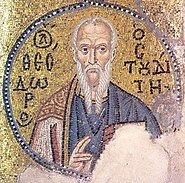Theodore Stoudites
| Theodore the Studite | |
|---|---|

|
|
| Monk | |
| Born | 759 |
| Died | 826 |
| Venerated in |
Eastern Orthodox Church Eastern Catholic Churches Roman Catholic Church |
| Feast | 11 November |
Theodore the Studite (also known as Theodorus Studita, St. Theodore of Stoudios, and St. Theodore of Studium; 759–826) was a Byzantine Greek monk and abbot of the Stoudios Monastery in Constantinople. Theodore's letter, containing suggested monastery reform rules, is the first recorded stand against slavery. He played a major role in the revivals both of Byzantine monasticism and of classical literary genres in Byzantium. He is known as a zealous opponent of iconoclasm, one of several conflicts that set him at odds with both emperor and patriarch.
Theodore was born in Constantinople in 759. He was the oldest son of Photeinos, an important financial official in the , and Theoktiste, herself the offspring of a distinguished Constantinopolitan family. The brother of Theoktiste, Theodore's uncle Platon, was himself an important official in the imperial financial administration. The family therefore controlled a significant portion, if not all, of the imperial financial administration during the reign of Constantine V (r. 741–775). Theodore had two younger brothers (Joseph, later Archbishop of Thessaloniki, and Euthymios) and one sister, whose name we do not know.
It has often been assumed that Theodore's family belonged to the iconodule party during the first period of Byzantine Iconoclasm. There is however no evidence to support this, and their high position in the imperial bureaucracy of the time renders any openly iconodule position highly unlikely. Furthermore, when Platon left his office and entered the priesthood in 759, he was ordained by an abbot who, if he was not actively iconoclastic himself, at the very least offered no resistance to the iconoclastic policies of Constantine V. The family as a whole was most likely indifferent to the question of icons during this period.
According to the later hagiographical literature, Theodore received an education befitting his family's station, and from the age of seven was instructed by a private tutor, eventually concentrating in particular on theology. It is however not clear that these opportunities were available to even the most well-placed Byzantine families of the eighth century, and it is possible that Theodore was at least partially an autodidact.
...
Wikipedia
